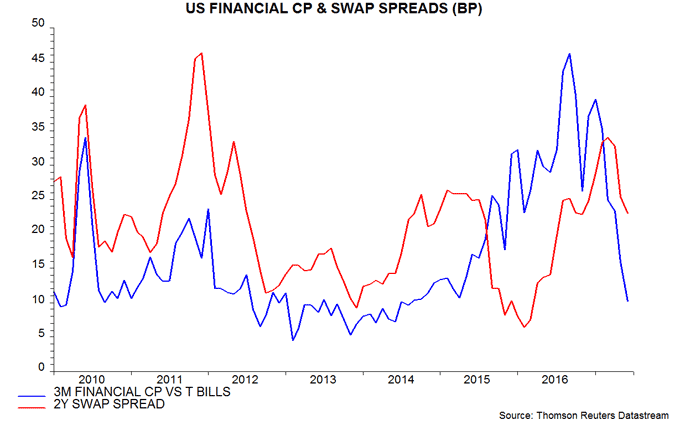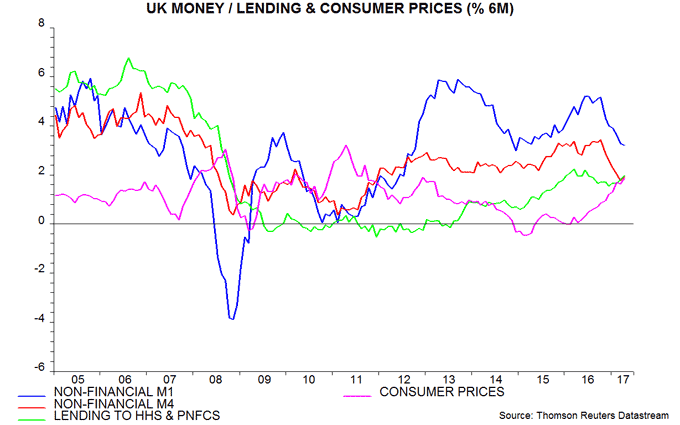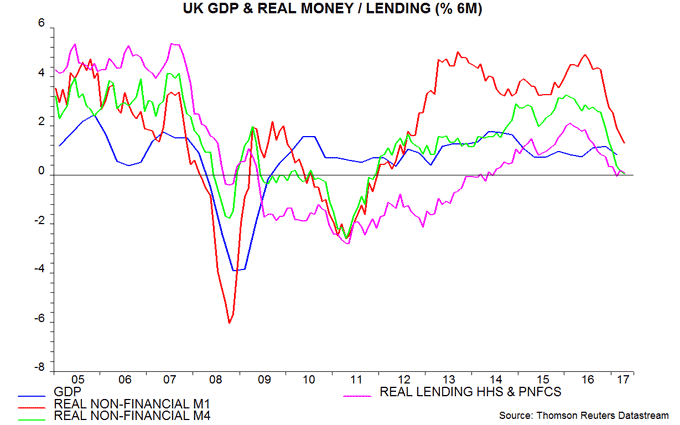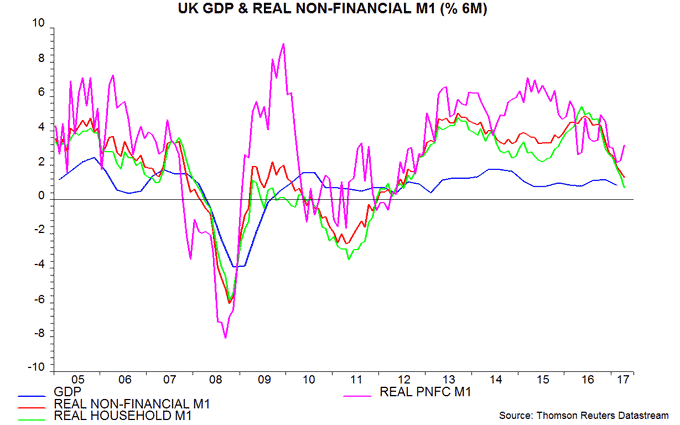Entries from May 28, 2017 - June 3, 2017
US monetary pick-up suggesting faster Fed tightening
Recent US narrow money acceleration continued in the latest week. The last real money growth data point in the chart below is a June projection assuming that the level of narrow money stabilises at its latest reading (week ending 22 May) and consumer prices rise by 0.2% in both May and June.
The continued pick-up is consistent with the story of a monetary boost from the normalisation of bank funding markets following the disruptive effect last year of money fund regulatory reform.
This US monetary boost may explain the buoyancy of US / global equity markets despite evidence that global economic momentum is rolling over, e.g. the manufacturing PMI fell to a six-month low in May.
The monetary pick-up, however, suggests that US growth will buck the global trend and rebound strongly by late 2017, in which case the Fed may need to step up the pace of tightening to prevent labour market overheating. The market may be complacent in discounting only a 50% probability of more than one quarter-point rate hike, and just 10% of more than two, over the remainder of 2017 (CME FedWatch tool).
UK real money growth at 5+ year low
The UK narrow and broad money measures tracked here posted respectable monthly rises in April but their six-month growth rates remain much lower than last autumn. With six-month consumer price inflation rising further in April, real-terms growth continued to subside, to its lowest since 2011-12. GDP growth will probably rebound in the second quarter but these trends suggest a significant slowdown during the second half. Household money growth has fallen by more than corporate growth, consistent with consumer-led weakness.
The narrow non-financial M1 aggregate rose by 0.7% in April but six-month growth edged down further to 3.2% – the lowest since 2014 and down from 5.2% in October 2016. The broader non-financial M4 measure increased by 0.5% in April, while six-month growth recovered slightly, though is also much lower than last autumn – see first chart.

Real money trends have been further squeezed by a sharp rise in the six-month rate of change of consumer prices (seasonally adjusted), which reached 1.9% in April, or 3.8% annualised.
Six-month growth rates of real non-financial M1 and non-financial M4 in April were, therefore, the weakest since 2012 and 2011 respectively – second chart.
The third chart shows real non-financial M1 growth broken down between households and private non-financial corporations (PNFCs). Household growth is weaker, consistent with a consumer-led economic slowdown. A recent uptick in PNFC growth is reassuring, suggesting that companies are still planning to expand investment and employment. (PNFC real narrow money has contracted before recessions historically.)

The focus here is on non-financial aggregates because financial sector money holdings contain little information about near-term prospects for spending on goods and services, and are often distorted by special factors. The Bank of England’s M4ex broad money measure rose by 7.3% in the year to April, outpacing a 5.4% increase in non-financial M4, reflecting strong growth in deposits held by insurance companies and pension funds, other fund managers and securities dealers. Part of this deposit rise may be connected with the implementation of liability-driven investment strategies by or for pension funds, with no economic implications. In addition, institutions may have switched out of Treasury bills and repos with the Debt Management Office (DMO) into bank deposits, i.e. M4ex overstates the growth of their total liquid assets. The stock of Treasury bills and “other central government debt” (mainly DMO repos) held by the private sector fell by £23 billion in the year to April.
The old M4 measure is even stronger than M4ex, rising by 8.2% in the year to April, reflecting a surge in deposits from “central clearing counterparties” – these increased by £56 billion, equivalent to 2.6% of M4, in the latest 12 months. Such deposits mostly represent indirect interbank lending and are unrelated to economic activity. Analysts focusing on M4ex or M4 are liable to overestimate economic prospects.
Euroland money trends signalling steady growth
The consensus has become more bullish about Eurozone economic prospects but real money trends are stable, suggesting that GDP will continue to expand at its recent pace of 1.75-2.0% per annum. Country detail shows that French overnight deposits are growing strongly, which may herald post-election economic acceleration. US real narrow money expansion, meanwhile, is catching up with and may soon exceed the Eurozone pace, cautioning against extrapolating recent Eurozone GDP growth outperformance.
The preferred narrow and broad monetary aggregates here are non-financial M1 / M3, which cover holdings of households and non-financial corporations, omitting volatile financial sector deposits. Six-month growth of real (i.e. inflation-adjusted) non-financial M1 edged down in April but remains slightly above its average over 2014-16 – see first chart. Real non-financial M3 growth is slightly below its corresponding average. GDP expanded at an average annualised rate of 1.9% over the 10 quarters from the third quarter of 2014 to the first quarter of 2017. A similar pace of growth, therefore, seems likely over the remainder of 2017.
Hopes of faster growth have been raised by recent strong purchasing managers’ survey results – the survey’s compiler, for example, claims that the flash May composite activity reading is consistent with a quarterly GDP increase of 0.6-0.7%, i.e. 2.4-2.8% annualised. This buoyancy, however, may partly reflect a temporary sentiment boost from the French presidential election result. The new orders component of the survey was less bullish than the headline activity series, falling to a four-month low.
M1 comprises currency and overnight deposits. A country breakdown is available for the latter and shows a further pick-up in French real deposit growth in April – second chart. A positive interpretation is that households and firms increased their holdings of narrow money in anticipation of boosting spending after the election. An alternative possibility, however, is that money was shifted into overnight accounts as a precaution to enable an immediate transfer out of the country in the event of a negative result.
US six-month real narrow money growth fell well beneath the Eurozone level in late 2016, casting doubt on the consensus forecast at the time of US relative economic strength. As previously discussed, US money and credit trends are now recovering and the real narrow money growth gap may have almost closed in May, based on weekly US data and assuming stable Eurozone expansion – third chart. With the consensus now bullish about Eurozone prospects, US economic news is more likely to surprise positively later in 2017.

